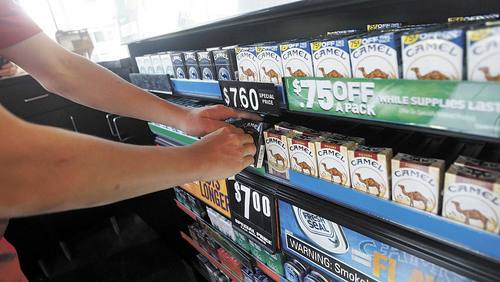Cigarette Taxes Linked to Binge Drinking
By Elbert Chu, Associate Producer, MedPage Today
Cigarette tax hikes were associated with a drop in the number of binge drinking bouts among male smokers and the amount of alcohol consumed when they did drink, investigators found.
Compared with male smokers who were not hit with any cigarette tax increases, those who were binged seven fewer times a year — a 22% drop — and drank 11% less — roughly a third of a drink — per “episode,” according to a study published online inAlcoholism: Clinical and Experimental Research.
Excessive drinking costs the U.S. about $234 billion each year, noted Sherry A. McKee, PhD, of Yale University School of Medicine and colleagues.
“We were surprised at the strength of the associations between increases in cigarette taxes and reductions in alcohol consumption,” McKee told MedPage Todayin an interview. She and her co-authors noted that to their knowledge, “no prior study has considered the potential for crossover association of cigarette taxation on drinking outcomes using a longitudinal, epidemiological U.S. sample.”
The researchers dug into prospective surveys of 21,473 U.S. alcohol drinkers from theNational Epidemiological Survey on Alcohol and Related Conditions. Two data sets provided the before-and-after cigarette tax increases. One set from 2001 and 2002, and another from 2004 and 2005.
Among the sample, 51% lived in the 31 states that increased cigarette taxes. Increases ranged from seven cents to $1.60 (mean = 61 cents, SD= 42 cents, median = 40 cents).
The investigators also accounted for alcohol prices, education, marriage status, and ethnicity. They further stratified their sample by age, drinking level, sex, and income.
The survey asked respondents about their drinking habits in the previous 12 months on a scale that ranged from “every day” to “never in the last year,” and how many drinks in consumed in each bout. Drinking was classified as “hazardous” when men reported downing more than 14 drinks per session, or women seven drinks. Also labeled as a “hazardous” drinker was anyone who binged at least once in the year they were surveyed.
Only people who said they smoked daily were included as smokers. Smokers who were also hazardous drinkers were more likely male, younger, and less likely to be married, compared with other drinkers.
Women drinkers showed no associated response to increased cigarette taxes. McKee attributed the difference between the sexes to higher rates of male drinkers in the U.S. population. “Eight percent of the population meets the criteria for alcohol use disorder. Out of that, five percent are men and three percent are women,” she told MedPage Today.
In young adults ages 18 to 29, increased cigarette taxes reduced the frequency of binge drinking (b= -0.19, P= 0.02). A similar effect was seen among smokers 50 and older (b = -0.23,P=0.04). Non-smokers showed no changes in their drinking habits.
“Nicotine acts with specific receptors in the brain unrelated to alcohol but have non-nicotine compounds that induce triggers and cues unrelated to nicotine receptors,” said Gregory N. Connolly, DMD, MPH, faculty director for the Center for Global Tobacco Control at the Harvard School of Public Health. “So the researchers may have found something big.
“We do know the opposite is true. Alcohol and the social acceptance of smoking in the bar induces relapse. The bar or pub has become the nicotine classroom for the young,” Connolly continued.
The primary limitation of the study was the reliance on people to accurately recall and record their drinking habits. In addition, the timing of the tax increases was not consistent across all states, nor does the data account for online or bulk purchases of alcohol that could be exempt from taxes.
“Absolute magnitude of increases in cigarette taxes was in the direction expected (greater increases in tax were associated with less heavy and less frequent drinking); however, the pattern of results was unchanged,” the authors wrote. It is unclear whether there’s any upper limit to the effect of increased taxes and associated drinking reductions, McKee said.
To be sure, there are other avenues for future research on other associated behaviors mentioned in the study like the rates of sex crimes and drunk driving among youth.
Although there are attempts to develop a safer cigarette underway, “smoking is the number one leading cause of morbidity in the U.S., and alcohol is the number three preventable cause of morbidity,” McKee said. “This study suggests that there are positive spillover effects to enacting these tax policies. If you can change one, you’re likely to change the other behaviour.”
Smokers are more likely to drink too much alcohol, particularly more vulnerable young men. With both behaviors so closely linked, what are the most effective strategies you use with your patients to curb binge drinking? Let us know by Adding Your Knowledge below. — Sanjay Gupta, MD
http://www.medpagetoday.com/theguptaguide/publichealth/40918



